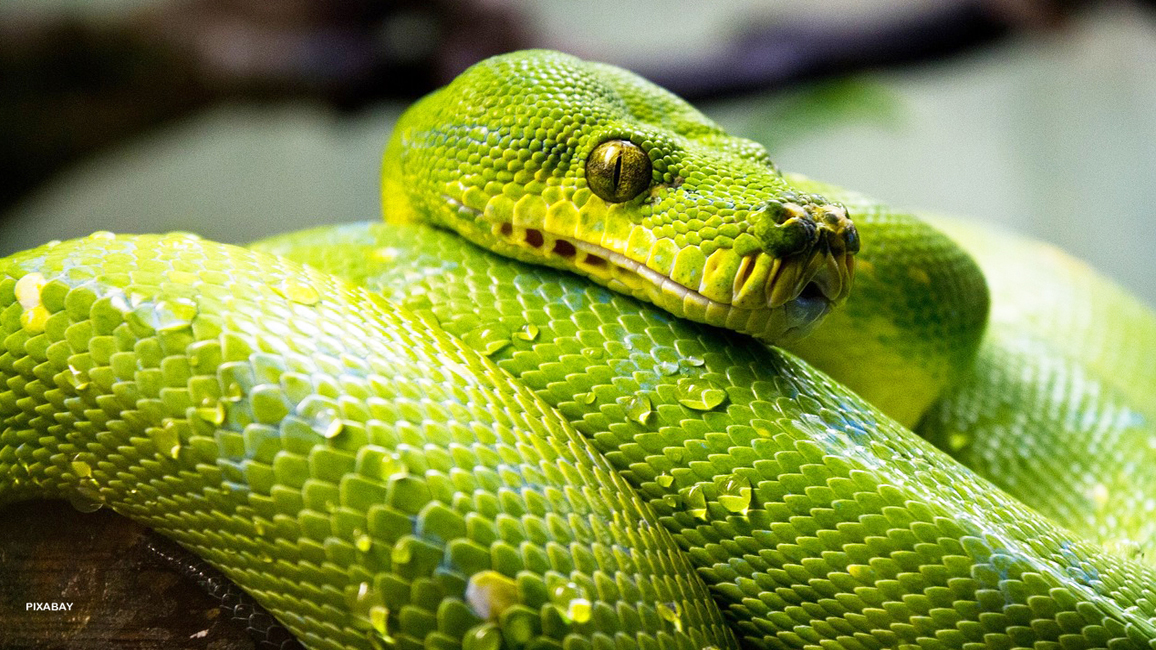
Squeezers
By Ellen LambethWith no arms or legs, snakes must somehow capture other animals for food. Meet the snakes that do it by putting the squeeze on their meals.

Many snakes eat small stuff and just use the grab-gulp-and-go method. But many others deal with bigger or more difficult prey. So they need some extra help in getting their meals under control.
Venomous snakes, such as rattlesnakes and other vipers, use bites that inject venom into their prey. The venom kills the prey or makes it unable to move and resist.
Constrictors are snakes that get control over their prey by squeezing them. (Constrict is another word for “squeeze” or “tighten.”) See the “how-to guide” below to discover how constriction works.
Some of the most familiar constrictors are the boas and pythons. Though these two kinds are alike in some ways, they are different in others. Most boas, for example, live in tropical areas of the Americas, and most female boas bear live young. Pythons are found in tropical Asia, Africa, and Australia. Python moms lay eggs.
The emerald tree boa and green tree python look and behave a lot alike. But they live on different sides of the Earth.
A Nile crocodile is, itself, a mighty predator. But an African rock python has this one in a deadly grip.
PUTTING THE SQUEEZE ON:
A How-To Guide for Constrictors
- Strike and Bite: Get a good hold with teeth and jaws.
- Coil Up: Immediately loop lengths of body around prey.
- Constrict: Use muscles to tighten coils and hold.
- Finish: Prey’s heart will stop and organs will fail. Then it’s safe to start swallowing.
- BON APPÉTIT!

THE BIG SQUEEZE
The world’s biggest constrictor—indeed, biggest snake—is the green anaconda of South America. It can grow to be nearly as long as a schoolbus and weigh almost as much as three men. Jesús Rivas (shown above holding the head and front end of one of these giants) probably knows anacondas better than most. He should—he’s been studying them for years!
Jesús catches anacondas in the wild. He inspects them, releases them, and follows them over time. To track one, he first has to put a radio transmitter inside it. One way to do that is by getting the snake to swallow one. The transmitter doesn’t bother the snake but sends out a radio signal that Jesús can follow. By discovering where each snake goes and how it lives, Jesús can help people better understand these scaly giants.
FRIENDLY NEIGHBORS
No matter where you live in the United States, there is most likely a constrictor near you. Here are a few kinds you might come across.
Most kingsnakes are constrictors that eat just about anything, including mammals, birds, reptiles, amphibians, and eggs, plus insects and other invertebrates. They earn their name because they often eat other snakes—even venomous ones. Venom has no effect on kingsnakes. The California kingsnake above is just about to finish a rattlesnake meal. The harmless Mexican milk snake top right is a kingsnake that looks a lot like the venomous coral snake, which it sometimes eats.
A good snake to have around a barn or house is a ratsnake—one that catches mice and rats. Luckily, there are many different kinds. The corn snake (left) is a ratsnake that often hangs out in corn bins to catch grain-loving rodents. Also, its belly scales look like kernels of Indian corn. The eastern ratsnake (often simply called “black snake”), is the longest snake in North America. It can grow to eight feet or more.
This bullsnake may look like a big bully, with the pattern and pose of a rattlesnake about to strike. It may even hiss and twitch its tail in some dry leaves to sound like a rattlesnake. But never fear: This snake would much rather slither away from a threat. It’s a slow mover, though, so often tries bluffing its way out of trouble instead.
Maybe someday you’ll come across a constrictor catching prey in your own neighborhood. And maybe if you nicely ask it to “squeeze, please,” you’ll be lucky enough to see constriction in action!
















